Roof Components – How do they affect the overall cost?
By Editorial Team
Updated on April 14, 2025

We’re all grateful to have a roof over our heads, as the expression goes. The roof is one of the essential parts of a home, ensuring comfort for its occupants by providing protection from the elements and keeping the interior watertight. However, most people are unfamiliar with the various components that make up a roof, the roles they play, and how they affect the overall cost of a roofing project. Indeed, the cost of repairing or installing a roof largely depends on its components.
From soffits to vents, and including gutters and drip edges, this article will walk you through every part of a roof.
Here are some of the questions we’ll answer:
What are the components of a roof?
What are the different types of roofs and their parts?
Are there specific elements for sloped roofs?
How much do these different components cost?
What are the names of the main parts that make up a house's roofing system?
Due to our climate, homes must be completely waterproof to provide adequate comfort for residents. Over time, many elements have been added to basic roofs to improve their durability. Let’s take a look at the various parts of a roof and the role each one plays in creating a fully watertight and secure structure.
Roof Frame
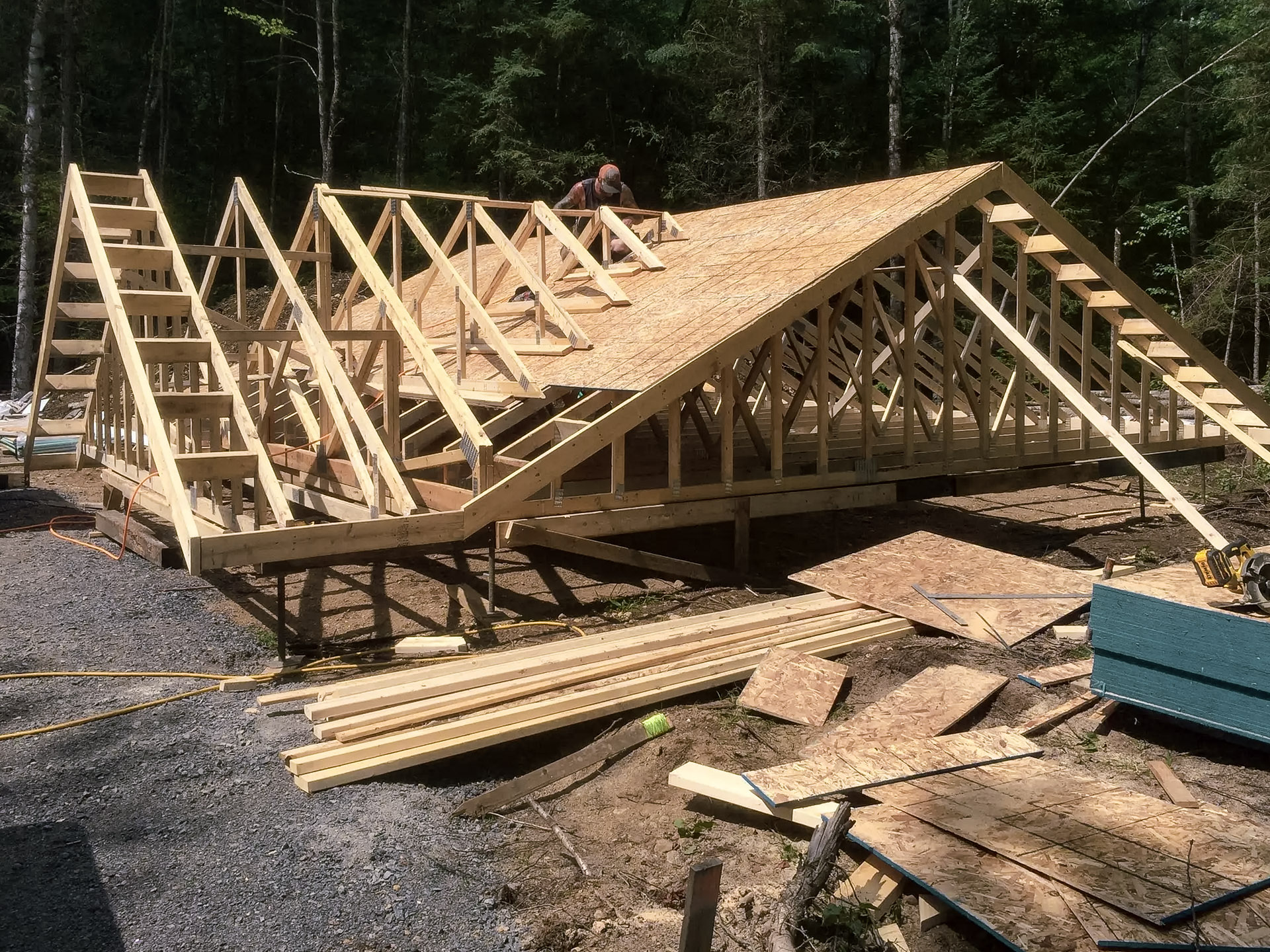
Source : Construction Léonard inc.
The frame is the foundational structure that holds up the roof and supports all its components. Often made of wood, it itself is composed of many parts.
The frame is designed to give the roof its shape—whether it’s sloped, flat, or mansard. Waterproofing layers and roofing material are then installed over the frame to complete the roof.
Price: between $50 and $200 per square foot
Roofing Underlayment
Before installing the exterior roofing material that covers most of the structure, underlayment must be installed. This layer must be waterproof while allowing adequate ventilation. It helps prevent water infiltration and damage from other types of weather.
Available underlayments in Canada include:
Asphalt-saturated cellulose fibers
Woven polypropylene membrane
Woven polyethylene membrane
Other synthetic fibers
Underlayment usually comes in the form of a self-adhesive membrane laid directly on the wooden frame. While relatively easy to install, it still requires some expertise to ensure proper placement. That’s why it’s best to hire qualified professionals.
Poor installation can compromise the roof’s lifespan and safety. Underlayment is just as important for flat roofs as for sloped ones—and even more so for green roofs, which we’ll discuss later.
Price: between $9 and $30 per square foot
Roofing Material
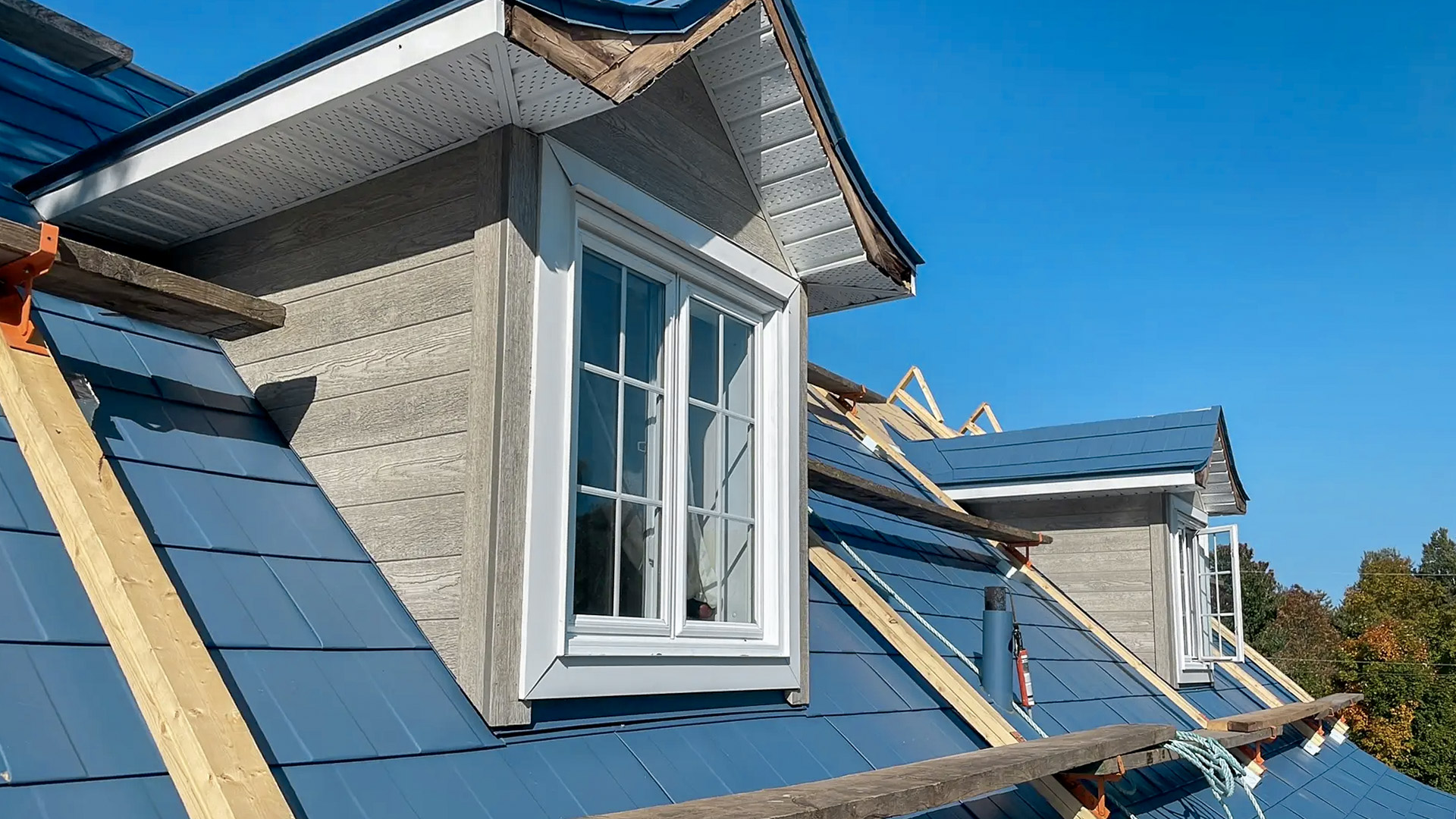
Source : Groupe Beaulieu construction
After the underlayment, the chosen roofing material is installed. We’ve written several articles about the different types of roofing materials, but here’s a summary of the options:
Asphalt shingles
Fiberglass shingles
Elastomeric membrane roofing
Wood shingles
Clay tiles
Concrete tiles
Slate tiles
Zinc roofing
TPO and EPDM (synthetic materials)
Metal roofing (aluminum, copper, steel)
Price: between $6 and $30 per square foot
Soffits
Soffits ensure roof ventilation. They’re installed in the overhanging parts of the roof (those that extend past the house walls). Made of perforated wood, aluminum, or PVC sheets, soffits not only allow ventilation but also serve an aesthetic function.
Price: approx. $10 per linear foot
Fascia Boards
Fascia boards are located near the soffits and help seal that area of the roof. These are usually aluminum or PVC strips installed where the soffits meet the roof. Gutters are often attached directly to the fascia.
Price: between $12 and $25 per linear foot
Gutters
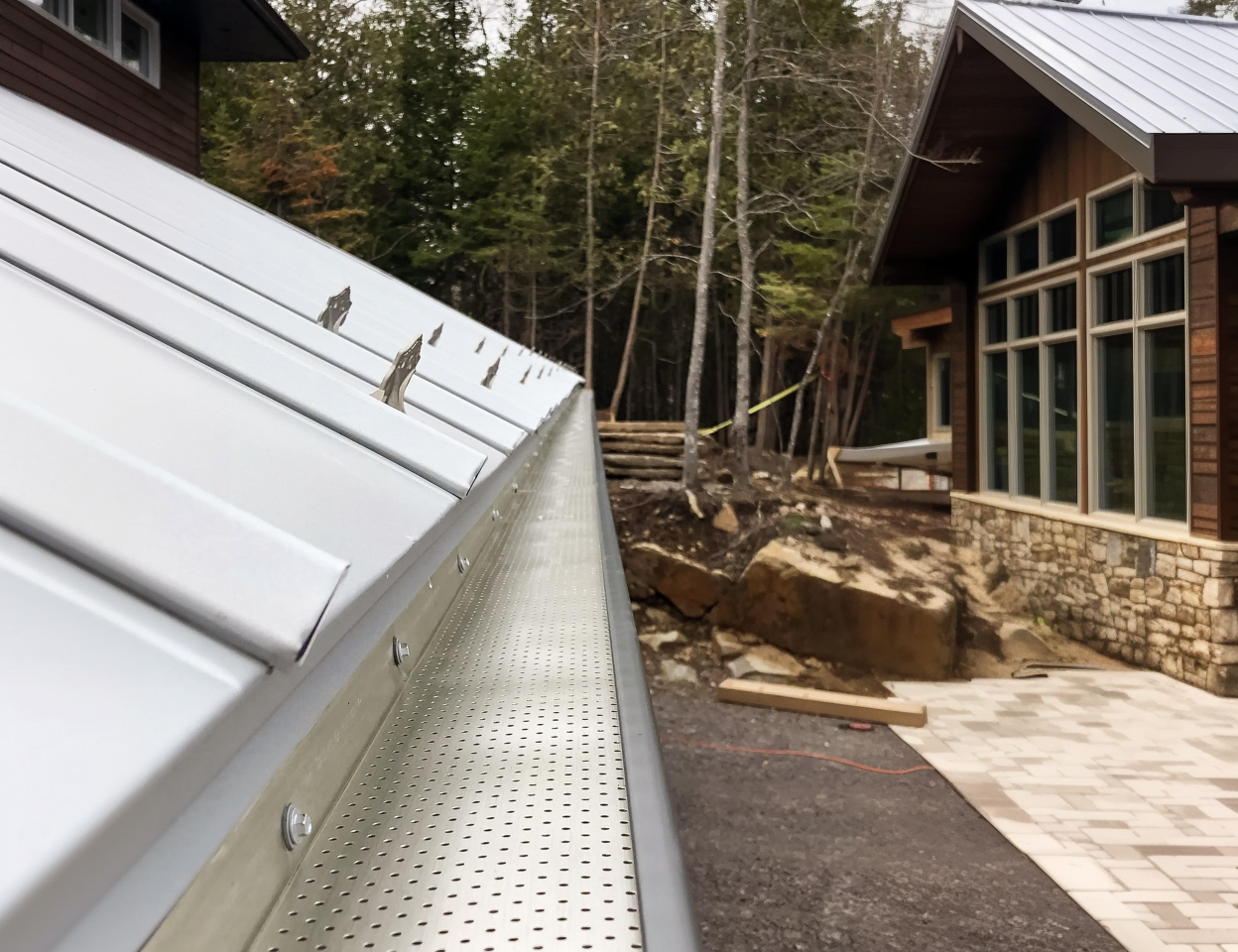
Source : Aluminium sauvé Inc.
Gutters play a critical role by protecting your roof, exterior siding, and foundations from water damage. They collect rainwater and direct it away from your home. Gutters are installed along the roof’s edge and are part of the roof’s drainage system, so they must be installed and maintained properly every season.
Price: between $3 and $35 per square foot
Flashing
Roof flashing is a waterproof joint in the form of trim or molding. It’s installed in places on the roof where waterproofing or energy loss could be a concern. Flashing is available in materials such as lead, aluminum, copper, or plastic (PVC).
Price: between $2 and $40 per square foot
Exhaust Vents (Plumbing and Ventilation)
Ventilation is a key factor in maintaining good indoor air quality. While windows and air exchangers help ventilate the interior, the roof also needs proper ventilation—this is the role of roof vents.
Poor roof ventilation can trap hot air inside, leading to problems like mold and premature material degradation.
Plumbing vents are connected to the plumbing system to balance pressure in the pipes and release harmful gases safely outside the house.
Price: between $60 and $100
Roof Vents (Exhaust Caps)
Roof vents also help ventilate air from range hoods, bathroom fans, and air exchangers. These elements are key to maintaining airflow and preventing moisture buildup in the attic or roof structure.
Price: between $60 and $100
What’s unique about a pitched roof?
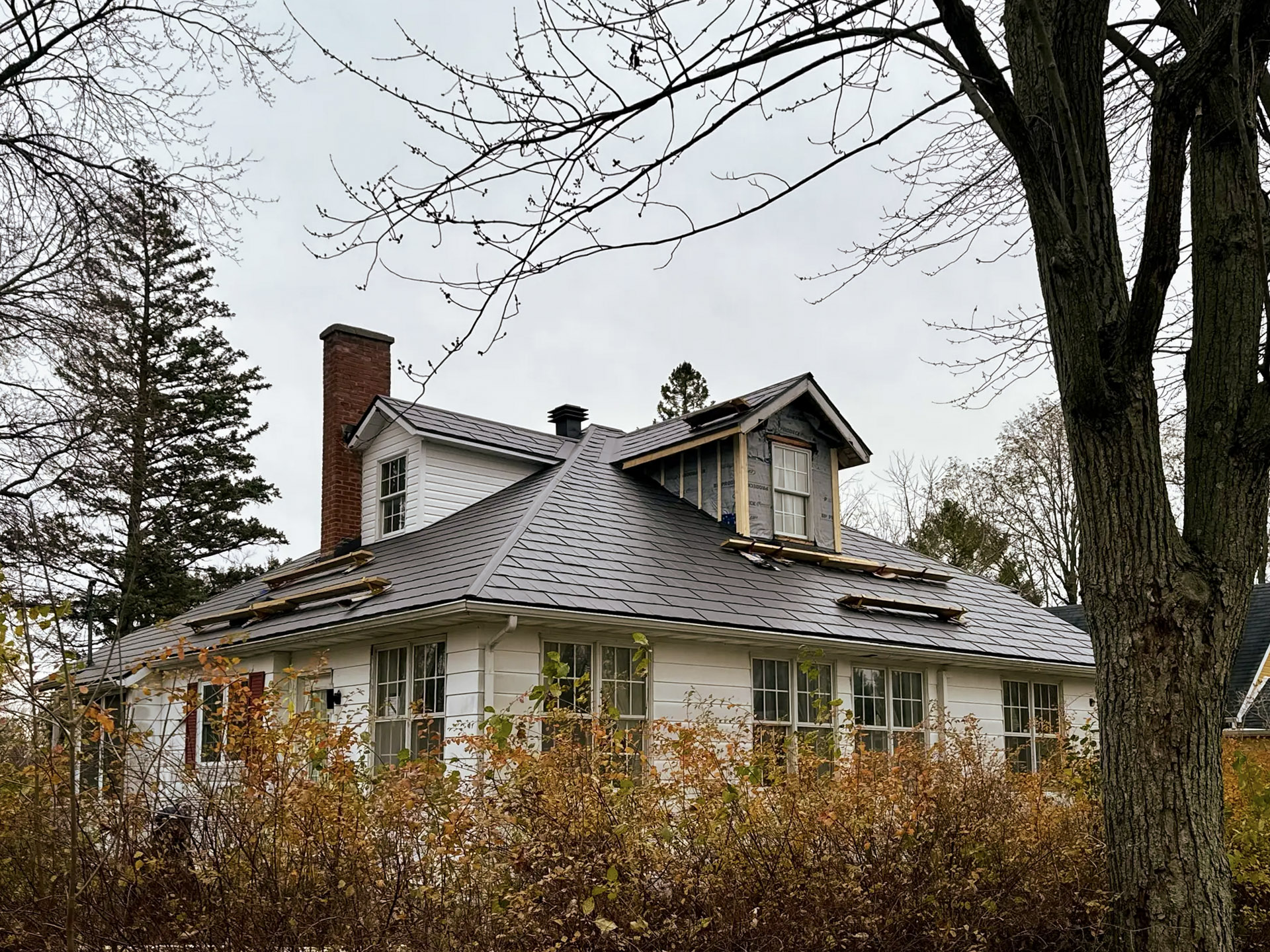
Source : TRX Mécanique
While most components listed so far can be found on all roof types (flat, sloped, or mansard), there are some components specific to pitched/sloped roofs.
Roof Valleys
Some sloped roofs have multiple sides that meet and form concave angles. Roof valleys are installed in these sections to protect them and guide water toward the slopes and eventually to the gutters.
Without valleys, water could accumulate and damage the roof.
Price: between $12 and $65
Gable Ends
Gable ends are triangular sections found on the façade of sloped roofs. Their design helps water drain away, reduces ice buildup in winter, creates attic space, and promotes ventilation. They also offer a visually appealing architectural style, suitable for both modern and classic designs.
Drip Edges
Drip edges are a type of flashing installed at the roof’s edge under the roofing material. Shaped like an L or T, they direct water into the gutters. They are available in galvanized steel, PVC, or aluminum.
Price: between $7 and $37
Ridge Caps
Ridge caps are crucial for roof waterproofing, along with flashing, drip edges, soffits, and fascia. On sloped roofs, ridge caps are installed where two sides of the roof meet.
The ridge is the highest point on a roof structure. If your roof has multiple slopes, there will be several ridges.
Price: between $17 and $71
Dormers
What could be more charming than a dormer on a sloped roof? These are windows that project out from the roof slope and are common in homes where the attic has been converted into living space (bedrooms, offices, lounges).
Building a Roof: What You Need to Know
The roof is one of the most important elements of a house—alongside the structure, foundation, windows, doors, and exterior siding. A faulty roof means the home will not be comfortable to live in.
Whether you’re installing or renovating a roof, never improvise. These jobs should always be carried out or at least supervised by professional roofers.
Roofing FAQ
What are the advantages of gable roofs?
Gable roofs offer excellent ventilation under the roof, promoting better airflow through the home. Their shape also makes it easier to gain living space by converting the attic. Plus, the sloped surface helps rainwater drain off easily, reducing the need for advanced drainage systems like those used for flat roofs.
How do you reinforce the roof frame?
If your roof structure needs reinforcement, it often involves the roof trusses (also known as “trusts” in English). These wooden structures support the rest of the roof (eaves, underlayment, accessories, and exterior covering).
Start by inspecting the current elements and replacing any damaged wood. If everything is intact but you plan to install a roof deck or garden, you may need to add beams or rafters.
Who should you call for roof repairs?
Always contact a certified roofer. Make sure they have experience with your type of roofing material and structure. Some companies specialize in certain roofing types, like shingles, flat roofs, or metal roofs. For major work, hire a specialist rather than a general contractor.
What is the most critical component of roof design?
The most critical component of roof design is the roof structure (or framing). This includes the beams, trusses, and rafters that provide the foundation and support for the entire roof system. Without a solid structure, the roof would not be able to support the weight of roofing materials or withstand external forces like wind, snow, and rain.
Which roof component is a fascia board fixed to?
A fascia board is typically fixed to the rafter ends or roof trusses. It runs along the edge of the roof, providing a smooth surface to attach gutters and protecting the roof from moisture damage. It also gives the roof a finished look.
What are roof finishing components?
Roof finishing components include the parts of the roof that provide both functionality and aesthetic appeal, such as:
Ridge caps: Installed at the peak of a sloped roof to ensure waterproofing.
Soffits: Installed under the roof's eaves for ventilation.
Fascia boards: Cover the ends of the rafters and provide a neat edge to the roof.
Gutters: Channel rainwater off the roof and away from the foundation.
Drip edges: Guide water into gutters and prevent water damage at the roof's edge.
Looking for something else?
Related articles
The latest industry news, interviews, technologies, and resources.

Editorial Team
•07 Nov 2023
As with all structural aspects of your home, wear and tear happen. Whether it’s a result of age, weather conditions, or a sudden incident, it’s important to be flexible and prepared when approaching necessary home renovations.

Editorial Team
•07 Nov 2023
When it comes to the ins and outs of owning a home, the roof may be last on the list of things we put time and attention into. Of course, the roof is a fundamental aspect of any well-maintained home, and its longevity will greatly affect the life of your house overall. Ventilation is a key part of maintaining a roof, so if you hadn’t considered roof vents before this moment, now is as good a time as any.

Editorial Team
•07 Nov 2023
The idea of renovating your house can sometimes spring up at an unexpected moment. Next thing you know, you find yourself browsing the internet looking for inspiration on Pinterest. However, if you're renting your apartment, it could be difficult to start any renovation projects. The final decision will be up to your landlord if you need to make any major changes to your space.
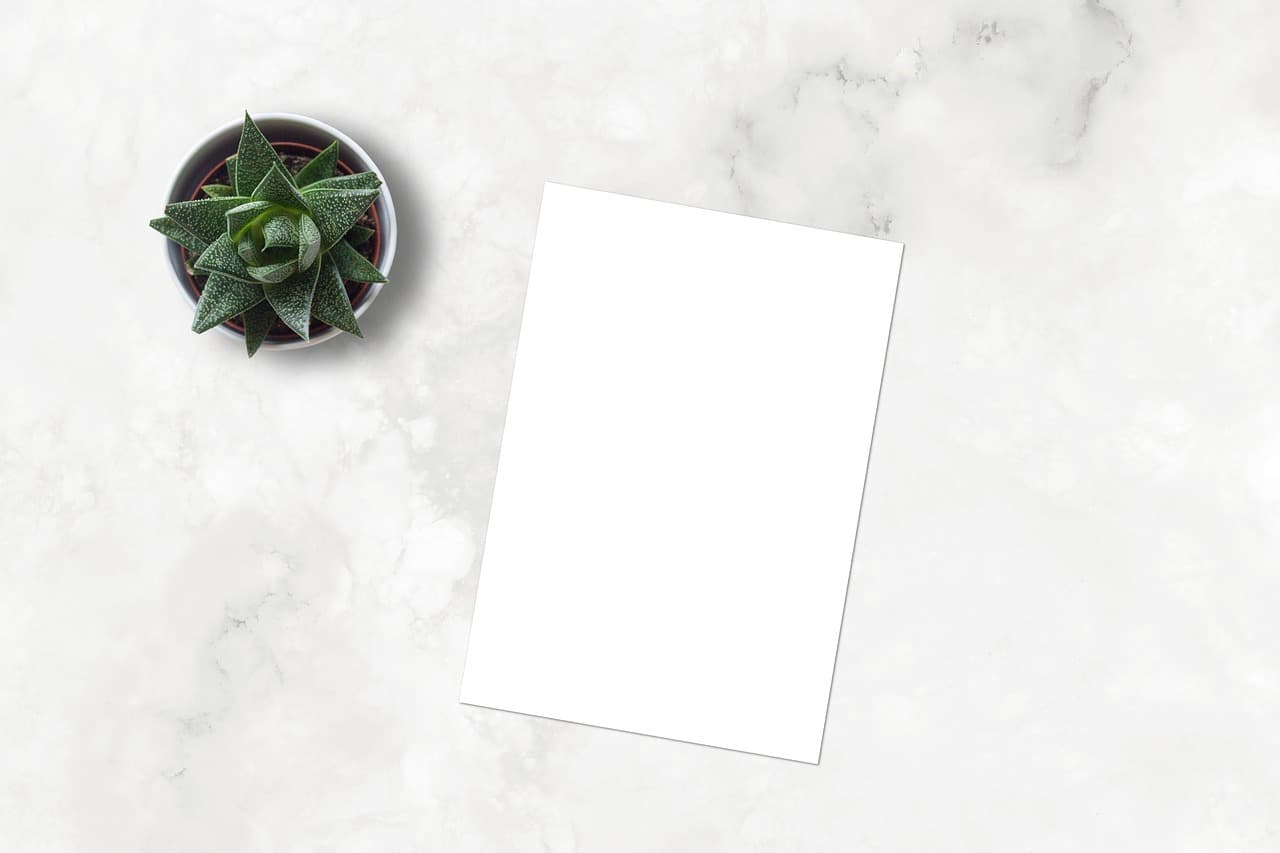
Karine Dutemple
•07 Nov 2023
Appreciated for its incomparable beauty and elegance, white marble is a material that is suitable both for bathrooms and kitchens, used as a surface on a kitchen island, as a countertop or as flooring.

Léa Plourde-Archer
•15 Dec 2025
Wondering how much it costs to install gutters in Canada? A reliable gutter system is essential for protecting your home from water damage, foundation issues, and costly repairs. Whether you’re replacing old gutters or outfitting a new build, understanding the average gutter installation cost—and the factors that influence it—can help you budget wisely.